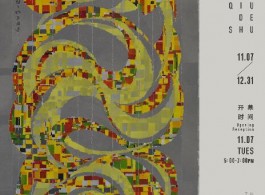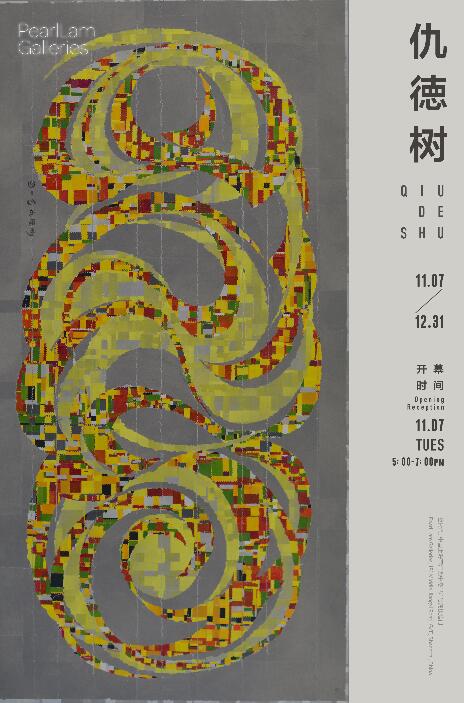Pearl Lam Galleries
Shanghai— Pearl Lam Galleries is pleased to present a retrospective of works by Chinese artist Qiu Deshu in Shanghai. The exhibition showcases his artworks from 1979 to the present, revealing the evolution of Qiu’s unique artistic language of “fissuring” as well as illustrating the importance of aesthetics and social value within his oeuvre.
Qiu Deshu was born to a family of intellectuals in Shanghai in 1948. He began his painting practice in his early childhood. In reaction to the restrictive hegemony of art by the Chinese Red Guard during the Cultural Revolution, he began to develop his own artistic ideas. This independent spirit led Qiu to co- found the Cao Cao She (Grass Society), which placed importance on independent thinking and cultivating a unique technique and style. Artists from this group used wild grass as a metaphor for their uninspiring yet energetic lives and hoped that their concepts about independent thinking and creation would ignite and spread like wildfire. However, their first exhibition was unexpectedly shut down having only been open for a few days because the abstract nature of the works was taboo, just like nude paintings. At the time, abstract art was far beyond public understanding and acceptance. Even though the first Cao Cao She exhibition only lasted for a couple of days, it is still a milestone that cannot be overlooked in the history of the emergence and development of contemporary art in China.
During the early 1980s, Qiu Deshu lived in oppression because he had founded the Cao Cao She. The unbearable psychological pressure caused him to experience a stroke, which left him with temporary facial paralysis and a brief loss of linguistic competence, when he was just 32 years old. Looking back at his life thus far, Qiu considers this time period as his lowest point; to him, it was even tougher than his time as a mineral worker during the Cultural Revolution. Through it all, Qiu tenaciously fought for independence and freedom of self-expression and artistic creation. When he was experiencing grief, depression, and/or boredom, he would walk around the deserted courtyard behind his studio. This is where he was first attracted to the beauty of the cracks in the rocks, which led to a sudden awareness of the silent but unavoidable natural power hidden in the slate cracks. This deeply inspired the metaphorical concept of his “Fissuring” series, which he uses to express his inner turmoil and emotions. In 1982, by tearing Xuan paper and reassembling the pieces with cracks in between, Qiu achieved a breakthrough in his artistic expression, paving the way for spiritual balance and self- healing.
After the political fallout Qiu experienced from founding the Cao Cao She, he was cast to the edges of the Chinese art world, where he remained for a long time. Instead, Qiu began exhibiting abroad. In 1982, his artworks were exhibited at the Smith College Art Museum in Northampton and the Brooklyn Museum in New York, USA. Then in 1985, he was invited to be an artist-in-residence at Tufts University near Boston. When he returned to Shanghai in 1986, Qiu became an independent artist outside the governmental system.
Prior to his time in the United States and his signature “Fissuring” series, Qiu’s early artistic explorations include what he calls “expressive ink brush” and “compositions by multiple seals”. The introduction of seals into paintings and its prevalence is related to Chinese traditional literati painting (or the Southern School of Chinese painting). Later on, the seals of collectors were also brought into paintings. They not only certified the authenticity and ownership of the painting, but also served as decoration for the graphic composition. Qiu’s art creation abandoned the conventional use of seals; he analysed and rearranged the seal’s square surface, making it a fundamental element in his compositions. These earlier experimentations were a reaction to prevailing art trends at the time and based on the reconstruction of traditional techniques and elements. It was not until he began to develop the unique artistic language he calls “fissuring” that the artist found his lifelong artistic style.
Qiu’s “fissuring” technique encompasses tearing Xuan paper, reconfiguring the pieces, and mounting them to form images, creating lines, or “fissures”, that travel across the painting’s expanse in a natural, free-flowing manner. The application of colour onto a painting is here subverted as well. Qiu rubs and carves the delicate rice paper, much like in creating a bas-relief, and builds this on top of a coloured base layer, such that the colours show through the layers and combine with the “fissures” to endow his works with a sense of dynamic rhythm and spatial complexity.
Qiu Deshu cultivated his own way of observing and expressing himself into a specific artistic language that departs from both traditional Chinese and Western painting. He makes Xuan paper a major element in his works, among traditional painting materials such as ink, silk, and Chinese pigment; he also strengthens the core meaning of paper as an “object” by utilizing his “fissuring” technique. In doing so, Qiu highlights the cultural meaning hidden in the material itself. The artist is deeply influenced by Chinese traditional philosophy. During his creation process, he equates himself with objects, and he works in dialogue with the material (Zhuangzi Philosophy – Equality of Things). By tearing, rubbing, and carving the Xuan paper, he highlights the nature of the material. Through external objects, he has developed his own metaphor to express his inner thoughts and artistic concepts. “Fissuring” not only reflects Qiu’s personal life experiences and way of thinking, but also depicts the common phenomenon in the context of rapid modernization and development in China today.
“Fissuring” seems to exist anywhere and anytime. It is the core principle of natural transformation both in the cosmos and in a microcosm. It destroys and constructs. It collapses and is reborn. Sharing the same ideas as old masters and ancient sages, humankind has consistently believed in the message of becoming one with nature, embracing the universe and communicating with one’s natural surroundings. As an intellectual with a strong social consciousness, Qiu Deshu has continued to use “fissuring” as the major theme of his artistic practice over the past 30 years. He has chosen a non-narrative method of expression to integrate his artworks into the contemporary social and cultural context of globalization and diversity.




